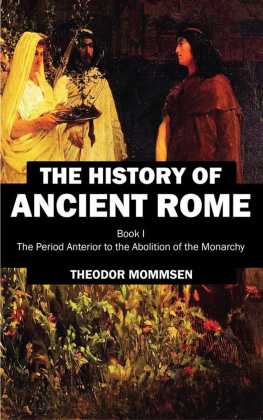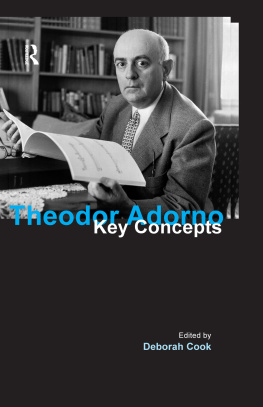Theodor Mommsen - The History of Rome. Book II
Here you can read online Theodor Mommsen - The History of Rome. Book II full text of the book (entire story) in english for free. Download pdf and epub, get meaning, cover and reviews about this ebook. genre: Science. Description of the work, (preface) as well as reviews are available. Best literature library LitArk.com created for fans of good reading and offers a wide selection of genres:
Romance novel
Science fiction
Adventure
Detective
Science
History
Home and family
Prose
Art
Politics
Computer
Non-fiction
Religion
Business
Children
Humor
Choose a favorite category and find really read worthwhile books. Enjoy immersion in the world of imagination, feel the emotions of the characters or learn something new for yourself, make an fascinating discovery.

- Book:The History of Rome. Book II
- Author:
- Genre:
- Rating:5 / 5
- Favourites:Add to favourites
- Your mark:
- 100
- 1
- 2
- 3
- 4
- 5
The History of Rome. Book II: summary, description and annotation
We offer to read an annotation, description, summary or preface (depends on what the author of the book "The History of Rome. Book II" wrote himself). If you haven't found the necessary information about the book — write in the comments, we will try to find it.
The History of Rome. Book II — read online for free the complete book (whole text) full work
Below is the text of the book, divided by pages. System saving the place of the last page read, allows you to conveniently read the book "The History of Rome. Book II" online for free, without having to search again every time where you left off. Put a bookmark, and you can go to the page where you finished reading at any time.
Font size:
Interval:
Bookmark:
version="1.0" encoding="windows-1251"?>sci_historysci_cultureTheodorMommsenThe History of Rome. Book II
The History of Rome by Theodor Mommsen, translated by William Purdie Dickson
endeBenjaminShoomowFB Writer v1.122 July 20098836606D-E948-41F6-84AA-9BA20DBF9DC01.0Ver 1.0 - , (The Project Gutenberg, www.gutenberg.net). (David Ceponis). , , , -xxx- --xxx-- .
The History of Rome. Book II
From the Abolition of the Monarchy in Rome to the Union of Italy
by THEODOR MOMMSEN
Translated with the Sanction of the Author by William Purdie Dickson, D.D., LL.D. Professor of Divinity in the University of Glasgow
A New Edition Revised Throughout and Embodying Recent Additions
Preparer's Note
This work contains many literal citations of and references to foreign words, sounds, and alphabetic symbols drawn from many languages, including Gothic and Phoenician, but chiefly Latin and Greek. This English Gutenberg edition, constrained to the characters of 7-bit ASCII code, adopts the following orthographic conventions:
1) Except for Greek, all literally cited non-English words that do not refer to texts cited as academic references, words that in the source manuscript appear italicized, are rendered with a single preceding, and a single following dash; thus, -xxxx-.
2) Greek words, first transliterated into Roman alphabetic equivalents, are rendered with a preceding and a following double-dash; thus, --xxxx--. Note that in some cases the root word itself is a compound form such as xxx-xxxx, and is rendered as --xxx-xxx--
3) Simple unideographic references to vocalic sounds, single letters, or alphabeic dipthongs; and prefixes, suffixes, and syllabic references are represented by a single preceding dash; thus, -x, or -xxx.
4) (Especially for the complex discussion of alphabetic evolution in Ch. XIV: Measuring And Writing). Ideographic references, meaning pointers to the form of representation itself rather than to its content, are represented as -"id:xxxx"-. "id:" stands for "ideograph", and indicates that the reader should form a picture based on the following "xxxx"; which may be a single symbol, a word, or an attempt at a picture composed of ASCII characters. E. g. -"id:GAMMA gamma"-- indicates an uppercase Greek gamma-form followed by the form in lowercase. Some such exotic parsing as this is necessary to explain alphabetic development because a single symbol may have been used for a number of sounds in a number of languages, or even for a number of sounds in the same language at different times. Thus, -"id:GAMMA gamma" might very well refer to a Phoenician construct that in appearance resembles the form that eventually stabilized as an uppercase Greek "gamma" juxtaposed to one of lowercase. Also, a construct such as -"id:E" indicates a symbol that with ASCII resembles most closely a Roman uppercase "E", but, in fact, is actually drawn more crudely.
5) Dr. Mommsen has given his dates in terms of Roman usage, A.U.C.; that is, from the founding of Rome, conventionally taken to be 753 B. C. The preparer of this document, has appended to the end of each volume a table of conversion between the two systems.
CONTENTS
BOOK II: From the Abolition of the Monarchy in Rome to the Union of Italy
I. Change of the Constitution - Limitation of the Power of the Magistrate
II. The Tribunate of the Plebs and the Decemvirate
III. The Equalization of the Orders, and the New Aristocracy
IV. Fall of the Etruscan Power - the Celts
V. Subjugation of the Latins and Campanians by Rome
VI. Struggle of the Italians against Rome
VII. Struggle Between Pyrrhus and Rome, and Union of Italy
VIII. Law - Religion - Military System - Economic Condition - Nationality
IX. Art and Science
BOOK SECOND
From the Abolition of the Monarchy in Rome to the Union of Italy
dei ouk ekpleittein ton suggraphea terateuomenon dia teis iotopias tous entugchanontas.
Polybius.CHAPTER I
Change of the Constitution - Limitation of the Power of the Magistrate
The strict conception of the unity and omnipotence of the state in all matters pertaining to it, which was the central principle of the Italian constitutions, placed in the hands of the single president nominated for life a formidable power, which was felt doubtless by the enemies of the land, but was not less heavily felt by its citizens. Abuse and oppression could not fail to ensue, and, as a necessary consequence, efforts were made to lessen that power. It was, however, the grand distinction of the endeavours after reform and the revolutions in Rome, that there was no attempt either to impose limitations on the community as such or even to deprive it of corresponding organs of expression - that there never was any endeavour to assert the so-called natural rights of the individual in contradistinction to the community - that, on the contrary, the attack was wholly directed against the form in which the community was represented. From the times of the Tarquins down to those of the Gracchi the cry of the party of progress in Rome was not for limitation of the power of the state, but for limitation of the power of the magistrates: nor amidst that cry was the truth ever forgotten, that the people ought not to govern, but to be governed.
This struggle was carried on within the burgess-body. Side by side with it another movement developed itself - the cry of the non-burgesses for equality of political privileges. Under this head are included the agitations of the plebeians, the Latins, the Italians, and the freedmen, all of whom - whether they may have borne the name of burgesses, as did the plebeians and the freedmen, or not, as was the case with the Latins and Italians - were destitute of, and desired, political equality.
A third distinction was one of a still more general nature; the distinction between the wealthy and the poor, especially such as had been dispossessed or were endangered in possession. The legal and political relations of Rome led to the rise of a numerous class of farmers - partly small proprietors who were dependent on the mercy of the capitalist, partly small temporary lessees who were dependent on the mercy of the landlord--and in many instances deprived individuals as well as whole communities of the lands which they held, without affecting their personal freedom. By these means the agricultural proletariate became at an early period so powerful as to have a material influence on the destinies of the community. The urban proletariate did not acquire political importance till a much later epoch.
On these distinctions hinged the internal history of Rome, and, as may be presumed, not less the history - totally lost to us - of the other Italian communities. The political movement within the fully-privileged burgess-body, the warfare between the excluded and excluding classes, and the social conflicts between the possessors and the non-possessors of land - variously as they crossed and interlaced, and singular as were the alliances they often produced - were nevertheless essentially and fundamentally distinct.
Abolition of the Life-Presidency of the CommunityAs the Servian reform, which placed the metoikos on a footing of equality in a military point of view with the burgess, appears to have originated from considerations of an administrative nature rather than from any political party-tendency, we may assume that the first of the movements which led to internal crises and changes of the constitution was that which sought to limit the magistracy. The earliest achievement of this, the most ancient opposition in Rome, consisted in the abolition of the life-tenure of the presidency of the community; in other words, in the abolition of the monarchy. How necessarily this was the result of the natural development of things, is most strikingly demonstrated by the fact, that the same change of constitution took place in an analogous manner through the whole circuit of the Italo-Grecian world. Not only in Rome, but likewise among the other Latins as well as among the Sabellians, Etruscans, and Apulians - and generally, in all the Italian communities, just as in those of Greece - we find the rulers for life of an earlier epoch superseded in after times by annual magistrates. In the case of the Lucanian canton there is evidence that it had a democratic government in time of peace, and it was only in the event of war that the magistrates appointed a king, that is, an official similar to the Roman dictator. The Sabellian civic communities, such as those of Capua and Pompeii, in like manner were in later times governed by a "community-manager" (
Next pageFont size:
Interval:
Bookmark:
Similar books «The History of Rome. Book II»
Look at similar books to The History of Rome. Book II. We have selected literature similar in name and meaning in the hope of providing readers with more options to find new, interesting, not yet read works.
Discussion, reviews of the book The History of Rome. Book II and just readers' own opinions. Leave your comments, write what you think about the work, its meaning or the main characters. Specify what exactly you liked and what you didn't like, and why you think so.





